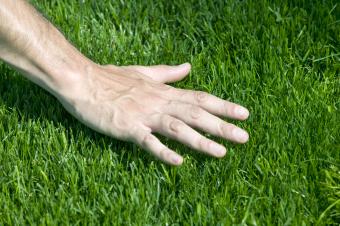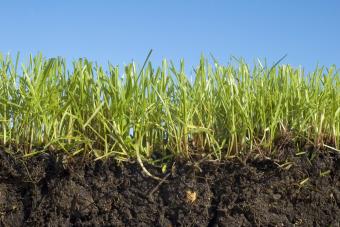
Bermuda grass is a popular turf grass for high traffic, hot, or dry areas. But the things that make it such a perfect choice for those challenging conditions also make it very challenging to get rid of if it makes its way into places where you don't want it to grow.
Methods for Killing Bermuda Grass
There are a few different ways to rid your garden or lawn of Bermuda grass, and the method you use will vary depending on where the Bermuda grass is growing and how much of it you're dealing with.
- Digging and pulling: Dig out the plant and its rhizomes, using a garden trowel or weeder.
- Smothering: Cover the area with cardboard or weed fabric and cover that with a three to six-inch layer of mulch. Leave covered for at least six to eight weeks to ensure anything growing in the area has died.
- Solarizing: This means securing black or clear plastic over the area, using pins, rocks, or soil to hold the edges down. The high heat kills any plants beneath the plastic, as well as any seeds in the soil.
- Herbicides: There are herbicides and homemade weed killers that will kill Bermuda grass, but you have to make sure they won't kill any desirable plants in the area. It's also worth keeping in mind that herbicides persist in the soil for months, and can have adverse effects on the health of both the gardener and wildlife, depending on the product. Often, these are applied by a licensed contractor.

Which Method Is Best?
The method you choose depends on what you wish to achieve:
- For a large, empty area that you plan to turn into a new lawn or garden bed later, consider smothering, solarizing, or using herbicides.
- For smaller areas, or those that don't have much Bermuda grass in them, digging and pulling, smothering, and solarizing work very well.
- If you're working around existing plantings, pulling is likely the simplest way to remove Bermuda grass.
Getting Rid of Bermuda Grass in Lawns
If Bermuda grass is invading an existing lawn, it can be difficult to get rid of the Bermuda grass because you may want to keep the rest of the lawn intact. There are a couple of methods that will work for you in this situation.
Dig or Pull Selectively
If you don't have a very large lawn, or you don't have an overwhelming Bermuda grass problem, you can pull the grass by hand.
- Identify the Bermuda grass so you dig that out and not desirable lawn grasses.
- Be sure to get the rhizomes and roots. To do this, you'll have to dig down about six inches and carefully pull. A hand trowel or dandelion digger are good tools for this.
- This will be a somewhat constant, regular chore at first. But the more you remove, the less Bermuda grass will pop up in your lawn over time.
Remove Everything
This method works well if your existing lawn is nothing special and you're fine with replacing everything.
- Remove all existing grass. You can do this quickly by stripping it with machinery (usually you'd rent a machine for this or hire someone to do it).
- If you're not impatient, you can smother the grass with cardboard and mulch for at least two months, then remove that and till the soil beneath, or you can place black or clear plastic over the area, which will kill the grass due to the high temperatures.
- Of course, you can also use an herbicide, but it's worth keeping in mind that these persist for months in the soil and can weaken growth of any plants you try to grow afterward.
- Once the grass is all gone, roto till to a depth of six inches and let the soil sit for another week or two to dry out any Bermuda grass rhizomes that were exposed by tilling.
- Remove any new Bermuda grass that sprouts.
- Sow grass seed or install sod when you don't see any more signs of Bermuda grass.

Getting Rid of Bermuda Grass in Garden Beds
It's a bit easier to get rid of Bermuda grass in garden beds than in lawns, only because there are clearly some plants you want to keep, and others (the Bermuda grass) that you want to get rid of, and the two are fairly easy to distinguish between.
Pulling and Digging Bermuda Grass Out of Gardens
If you're dealing with a small garden bed, it will probably be easiest (though a bit time consuming) to pull or dig out the Bermuda grass. This is the best solution for areas in which you have established perennials or shrubs, or tight spaces where you really can't work with something like a rototiller.
There are a few important things to keep in mind when using this method.
- Dig as much of the rhizomatous root system out as possible. The rhizomes are usually around six inches beneath the soil's surface. It might be easiest to use a trowel, carefully digging under the rhizomes, pulling it up as you go.
- Repeat as needed. It's unlikely that the first session of pulling and digging will eradicate the Bermuda grass from the bed. If there are pieces of rhizome left (and it's nearly impossible to get it all on one pass) then you'll have to pull and dig when you see it sprouting up again.
- Install edging to prevent Bermuda grass from spreading to beds. An edging that goes six inches down into the soil will prevent the rhizomes from spreading into your garden beds.
- Don't let the grass go to seed. Mow, pull, or dig any Bermuda grass in the area before seed heads appear. Once they do, the seeds will spread, and you'll have a whole new batch of Bermuda grass seedlings to deal with.
Using Herbicides in Garden Beds
Using an herbicide in a garden bed can get rid of the Bermuda grass, but it can also result in the death of the plants you want to keep as well. There are a few things you can do if you want to go with this method.
- Look for herbicides with the active ingredients product with the acting ingredients Fluazifop or Sethoxydim, both of which will work against Bermuda grass but are safe for shrubs and broad-leaved perennials.
- Carefully follow all the instructions on whatever product you use.
- Monitor the garden area to make sure the Bermuda grass doesn't reappear. If so, apply again according to the product's directions.
- Consider installing edging around the bed that goes down six inches below the soil's surface to keep the rhizomes from creeping back in.

Patience and Vigilance
The things that make Bermuda grass a great turf solution for tough spaces also make it a headache in other situations. It will take some effort to get rid of it, and vigilance to make sure it doesn't return, but it can definitely be done.







